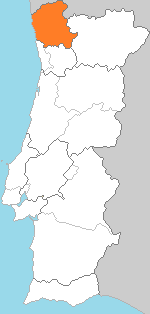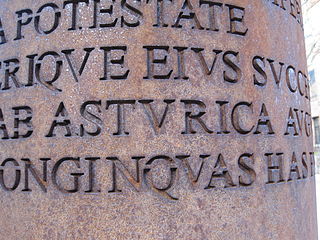
Lusitania was an ancient Iberian Roman province encompassing most of modern-day Portugal and a large portion of western Spain. Romans named the region after the Lusitanians, an Indo-European tribe inhabiting the lands.

Raetia or Rhaetia was a province of the Roman Empire named after the Rhaetian people. It bordered on the west with the country of the Helvetii, on the east with Noricum, on the north with Vindelicia, on the south-west with Transalpine Gaul and on the south with Venetia et Histria, a region of Roman Italy.

Braga is a city and a municipality, capital of the northwestern Portuguese district of Braga and of the historical and cultural Minho Province. Braga Municipality had a resident population of 201,583 inhabitants, representing the seventh largest municipality in Portugal by population. Its area is 183.40 km2. Its agglomerated urban area extends to the Cávado River and is the third most populated urban area in Portugal, behind Lisbon and Porto Metropolitan Areas.

Gallaecia, also known as Hispania Gallaecia, was the name of a Roman province in the north-west of Hispania, approximately present-day Galicia, northern Portugal, Asturias and Leon and the later Kingdom of Gallaecia. The Roman cities included the port Cale (Porto), the governing centers Bracara Augusta (Braga), Lucus Augusti (Lugo) and Asturica Augusta (Astorga) and their administrative areas Conventus bracarensis, Conventus lucensis and Conventus asturicensis.

The Astures or Asturs, also named Astyrs, were the Hispano-Celtic inhabitants of the northwest area of Hispania that now comprises almost the entire modern autonomous community of the Principality of Asturias, the modern province of León, and the northern part of the modern province of Zamora, and eastern Trás os Montes in Portugal. They were a horse-riding highland cattle-raising people who lived in circular huts of stone drywall construction. The Albiones were a major tribe from western Asturias. Isidore of Seville gave an etymology as coming from a river Astura, identified by David Magie as the Órbigo River in the plain of León, and by others as the modern Esla River.

The Bracari or Callaeci Bracari were an ancient Celtic tribe of Gallaecia, living in the northwest of modern Portugal, in the province of Minho, between the rivers Tâmega and Cávado. After the conquest of the region beginning in 136BC, the Romans established the Augustan citadel of Bracara, modern Braga, in 20 BC.

The Gallaeci were a Celtic tribal complex who inhabited Gallaecia, the north-western corner of Iberia, a region roughly corresponding to what is now the Norte Region in northern Portugal, and the Spanish regions of Galicia, western Asturias and western León before and during the Roman period. They spoke a Q-Celtic language related to Northeastern Hispano-Celtic, called Gallaecian or Northwestern Hispano-Celtic. The region was annexed by the Romans in the time of Caesar Augustus during the Cantabrian Wars, a war which initiated the assimilation of the Gallaeci into Latin culture.

The Iberian Peninsula, where Galicia is located, has been inhabited for at least 500,000 years, first by Neanderthals and then by modern humans. From about 4500 BC, it was inhabited by a megalithic culture, which entered the Bronze Age about 1500 BC. These people would become the Gallaeci, and they would be conquered by the Roman Empire in the first and second centuries AD. As the Roman Empire declined, Galicia would be conquered and ruled by various Germanic tribes, notably the Suebi and Visigoths, until the 9th century. Then the Muslim conquest of Iberia reached Galicia, although they never quite controlled the area.

Castro culture is the archaeological term for the material culture of the northwestern regions of the Iberian Peninsula from the end of the Bronze Age until it was subsumed by Roman culture. It is the culture associated with the Gallaecians and Astures.

Minho was a former province in Portugal, established in 1936 and dissolved in 1976. It consisted of 23 municipalities, with its capital in the city of Braga. Today, the area would include the districts of Braga and Viana do Castelo. Minho has substantial Celtic influences and shares many cultural traits with neighbouring Galicia, in northwestern Spain. The region was part of the Roman Province and early Germanic medieval Kingdom of Gallaecia. Historical remains of Celtic Minho include Briteiros Iron Age Hillfort, the largest Gallaecian native stronghold in the Entre Douro e Minho region, in north Portugal. The University of Minho, founded in 1973, takes its name from the former province.

The Via Augusta was the longest and busiest of the major roads built by the Romans in ancient Hispania. According to historian Pierre Sillières, who has supervised excavation of Roman sites in Spain to identify the exact route followed by the Via Augusta, it was more a system of roads than a single road. Approximately 1,500 km (930 mi) long, the Via Augusta was built to link Spain with Italy, running from the southwestern coastal city of Gades (Cádiz) to the Pyrenees Mountains along inland valleys parallel to the coast of the Mediterranean Sea. As the main axis of the road network in Roman Hispania, it appears in ancient sources such as the itinerary inscribed on the Vicarello Cups as well in as the Antonine Itinerary.

A Rúa is a mostly rural municipality in the province of Ourense, in the autonomous community of Galicia, Spain. It belongs to the comarca of Valdeorras. It is 101 km (63 mi) from the provincial capital, Ourense. An inhabitant of the area is known as a rués.
Portus Cale was an ancient town and port in present-day northern Portugal, in the area of today's Porto and Vila Nova de Gaia. The name of the town eventually influenced the name of the subsequent country of Portugal, from the 9th century onwards.

The Conventus Lucensis, was a Roman administrative unit located in the northwest of the Iberian Peninsula, in Gallaecia. Its name derives from its capital Lucus Augusti, the most important city in this convent, economical and administrative center of the country. Its Southern borders were marked by the river Verdugo, and the river Sil (limit with the Conventus bracarensis, in the north the coastline from Morrazo until river Navia, in the East the Ancares' mountains and the Conventus asturicensis.
The territory of modern-day Portugal was Romanized following the events of the Second Punic War, through the Roman conquest of the Iberian Peninsula.

The Battle of the Nervasos Mountains occurred in the year 419 and was fought between a coalition of Suebi, led by King Hermeric together with allied Roman Imperial forces stationed in the Province of Hispania, against the combined forces of the Vandals and Alans who were led by their King Gunderic. This battle occurred in the context of a contemporary Germanic invasion of the Iberian Peninsula. The battle took place in what is today the Province of León, Spain, and resulted in a Roman/Suebian Victory.

The name of Galicia, an autonomous community of Spain and former kingdom on the Iberian Peninsula, derives from the Latin toponym Callaecia, later Gallaecia, related to the name of an ancient tribe that resided north of the Douro river, the Gallaeci or Callaeci in Latin, or Kallaikói (καλλαικoι) in Greek.
This article covers the history of ancient Portugal, the period between Prehistoric Iberia and County of Portugal.

Baeturia, Beturia, or Turdetania was an extensive ancient territory in the southern part of the Iberian Peninsula situated between the middle and lower courses of the Guadiana and the Guadalquivir rivers. From the Second Iron Age, it was inhabited by two distinct ethnic groups: the Celtici, who were Celtic Indo-Europeans in the west, and the Turduli, related to the Turdetans, in the east. The territory was annexed by Rome in the early 2nd century BC and became part of the province of Hispania Ulterior.

Asturica Augusta was a Roman city corresponding to the Spanish city of Astorga, in the province of León. Founded around 14 B.C. as a camp of the Legio X Gemina, at the beginning of the first century it developed as a civil center and was the capital of the Asturicense conventus iurudicus, within the province of Tarraconense.















